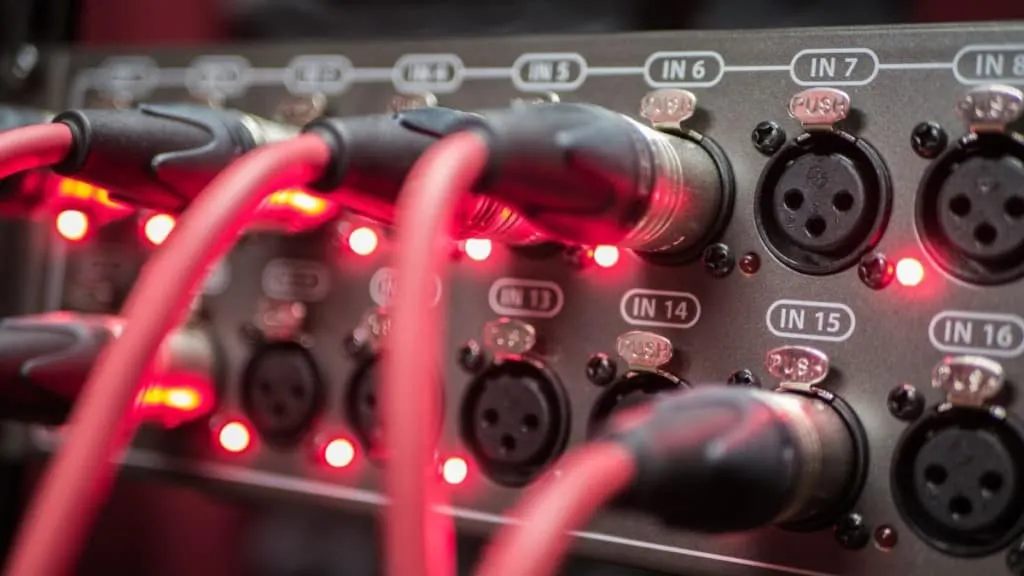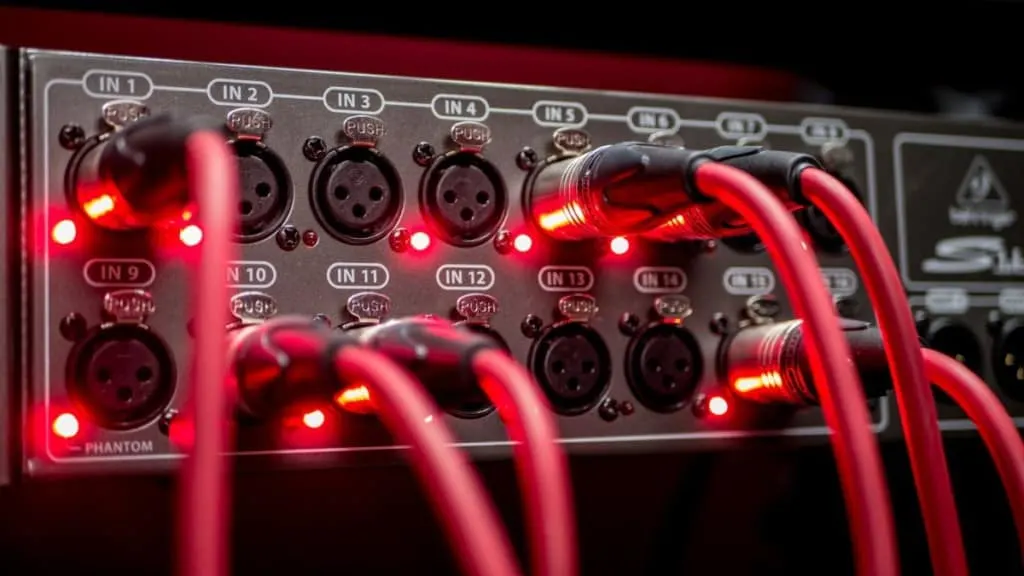Why are XLR cables called microphone cables? Can they be used to hook up an amplifier to speakers? Can you use an XLR cable to connect your sound card to powered monitors? In this article, we’ll sift through the clutter surrounding XLR cables, their uses, and their safety.
So, can XLR cables be used for speakers?
You can use an XLR cable for speaker connections and it should work fine if you have the right amp/preamp. However, using an XLR mic cable (the wrong type) might lead to damage. XLR mic cables are not the same as XLR speaker cables; they won’t be able to handle a high level of wattage.
External Line Return (or simply XLR) cables are designed with a circular 3-pin connector wherein each pin corresponds to positive, negative, and ground. They are balanced cables that were designed to pass electrical currents while keeping the signal clean.
XLR cables are preferred to other types of cables because they have a very low signal to noise ratio.
XLR cables are standardized equipment in the audio and recording industry and are used for a wide variety of devices. XLR cables can be used with speakers, mixers, amp, microphones, and other audio/recording gear.
That being said, there is a lot of confusion between the subtypes. So, let’s clear the air surrounding speakers and XLR cables and how/when/why they can be used:
Using XLR Cables For Speakers:
The main purpose of a cable is to transfer an electrical signal from point A to point B without degrading the quality or introducing any noise. A good cable should be flexible, durable, cost-effective, and have soldered connections.
It should be the right length and not disproportionately long. Long cables only complicate things because they are vulnerable to interference and noise. There are four main types of cables available in today’s market. They are:
- Patch Cables
- Instrument Cables
- Speaker Cables
- Microphone Cables
I have written an article called “How long can XLR cables be” You can read it here.
Back in the days, speakers and mics used XLR connectors and this is the root cause of this confusion. Today, almost no one uses XLR cables to hook up modern speakers. Instead, XLR cables have become the industry standard for connecting mic and line-level audio equipment.
In addition, speaker cables have evolved in a very different direction.

Cables For Speakers
Speaker cable is the wire applied for connecting speakers to the amplifier. It has three fundamental properties: capacitance, impedance, and inductance. All these properties are critical to consider before buying the cable.
Speaker cables usually have two to four identical medium to bulky gauge wires. Gauge with a smaller number, meaning thicker cables are used in between amplifiers and speakers, as these wires/cables need to transmit a powerful signal.
This type of cable is also known as an “unshielded” and “two-conductor” cable. Speaker cables have two connectors – positive and negative – that match the jacks of speaker input with amplifier output.
- Please note: you should not connect powered speakers to another device with cables that are not shielded. It will result in humming and radio interference, because of the lack of shielding.
I have written an article called “Why does my guitar amp pic up radio” You can read it here.
Modern Speaker Cables w/ Variations:
Today, speaker cables are unbalanced cables that use a variety of connectors like Speakon, binding post, ¼” jack, and banana clips. The SRS16-6 StageMASTER and Speakon to Speakon Audio Cord are a few examples of these cables.
Unlike mic cables, they are unbalanced cables that are designed with a heavier gauge conductor than other types of cables (i.e. patch, instrument, or mic cables). They need a heavy gauge and bigger wires as they carry significantly higher voltage signals.
It is uncommon to find a powered mixer with XLR outs nowadays. Nevertheless, if you have one of those old school mixers, then you must use XLR speaker cables. Again, these are special XLR speaker cables, not run of the mill XLR mic cables.
Difference Between XLR Microphone Cables And XLR Speaker Cables:
All XLR cables are not born equal, nor are XLR connectors. XLR cables can refer to XLR mic cables and XLR speaker cables, and these two types are very different from each other. Shielding and wire gauge are the key differences between the two subtypes.
The biggest fundamental difference between XLR mic and XLR speaker cables is the anatomy. XLR mic cables have two cores and a braided shield (balanced) to carry low-voltage/low-impedance signals. The Monoprice Premier Series or Mogami Gold Studio-10 are good examples of XLR microphone cables.
Speaker cables only need two cores and no shielding (unbalanced). Additionally, they require significantly thicker and heavy-duty cores compared to mic XLR cables. The confusion arises because both cables an XLR connector and the names on e-commerce platforms can be quite misleading.
Nevertheless, if you try to use microphone XLR cables for speaker connections without the right preamp, it can result in: damaged cables, damaged amp, or damaged speakers.
It is imperative to find and use the right cable to prevent damage to your equipment and to get the best possible sound from it. However, the quality of said speaker cable (as long as it is the right type) isn’t going to make or break the audio quality of your sound system.
So, you’ll need lower gauge (thicker) unbalanced cables between amps and speakers. These cables will carry a powered signal from your amp to the speakers. You need higher gauge (thinner) cables for microphones and instruments, or for anything similar that runs at mic or line level.

A little confused? Let’s recap:
- Thick Cables = Lower Gauge = carry powered signals (run from an amp to a speaker)
- Thin Cables = Higher gauge = carry line level (run from a mic to the mixer/PA/amp)
Related Questions: FAQ
What Is A Microphone Cable?
XLR cables were primarily designed to carry created to be used with Microphones. The cables of the Microphone are coaxial cables that have a center gauge wire with a braided shield. In simple words, the cable has a balanced pair in the middle to carry small voltages and a braided shield to protect them from outside interference.
What Is A Speaker Cable?
Speaker cables have two heavy conductors without shielding. Their purpose of a speaker cable is to carry the power (wattage) from an amplifier to a speaker. They lack shielding because it would make them vulnerable to electrical interference in radio frequency (20 kHz) environments.
Is An XLR Cable Better Than A ¼ Jack Cable?
Yes, 3-pin XLR connectors are generally considered better than ¼ jacks but each of them has distinct usage.
XLR cables have balanced audio. Their shielding/grounding protects the signal from electrical interferences. A common example of electrical interference is the sound you hear when your mobile phone is near audio equipment.
Does The Length Of A Cable Affect The Sound Quality?
The longer a cable, the more important the cable quality gets. When you use a long cable, it becomes vulnerable to interference. Longs cables need to have sufficient quality to protect the signal to ensure good results. A short cable is efficient in a cost-effective setup as long as it can reliably get the job done.
What Is The Best Length For A Speaker Cable?
You will find that most speaker cables are 8 to 10 feet, with 1 meter or 8ft cables being the norm. This length is practical and efficient. Long cables (as mentioned above) need to be of good quality to protect the signal. However, if your amps and speakers are situated far apart, you can go opt for cables as long as 5 meters.
Final Thoughts:
To sum up, it is important to connect the right cables to the right equipment, to get the best results.
This way, you prevent possible damage to the equipment and enjoy a high-quality sound output. So, next time when you buy cables or connect your devices, we are sure you will confidently make an informed choice.
